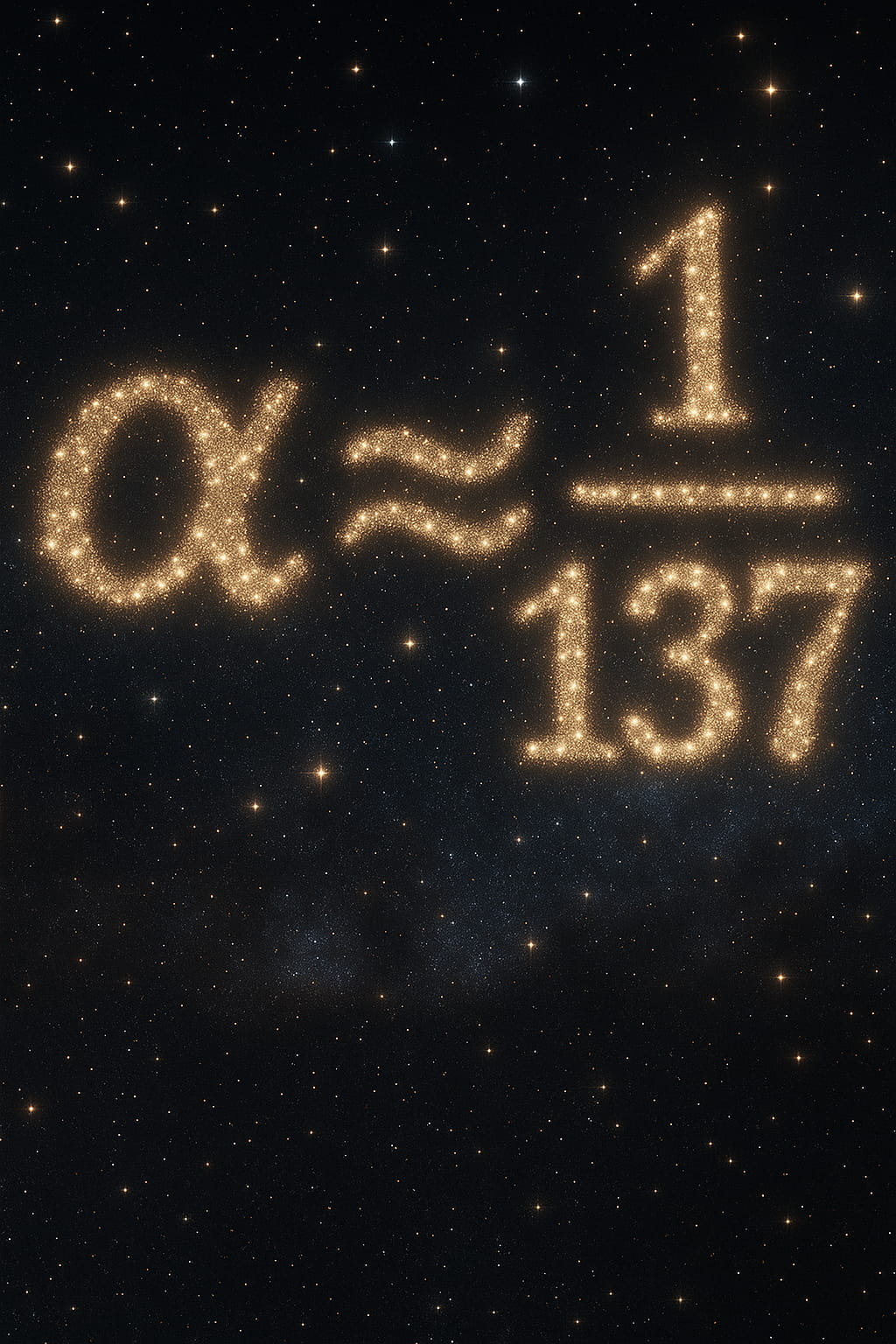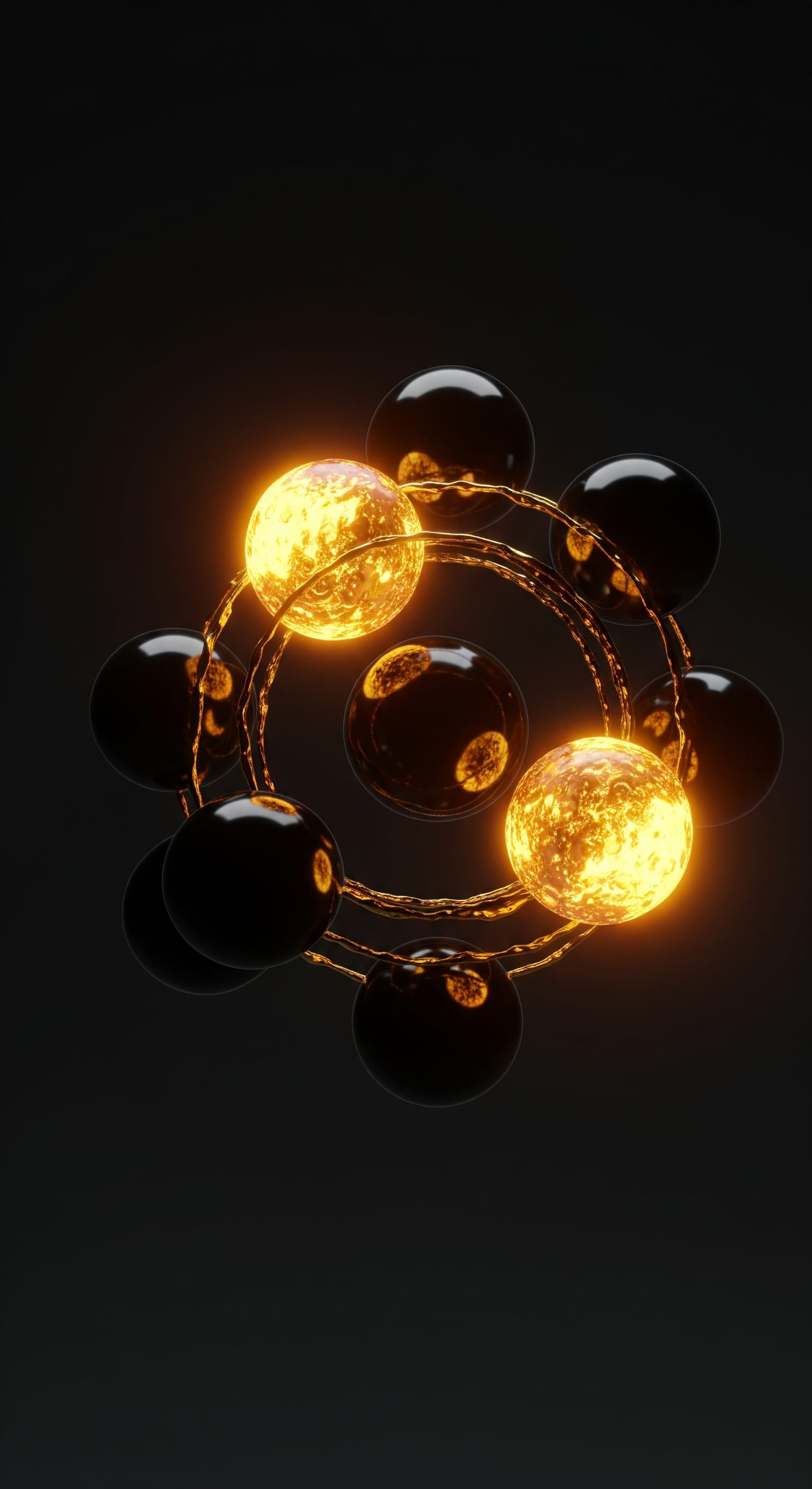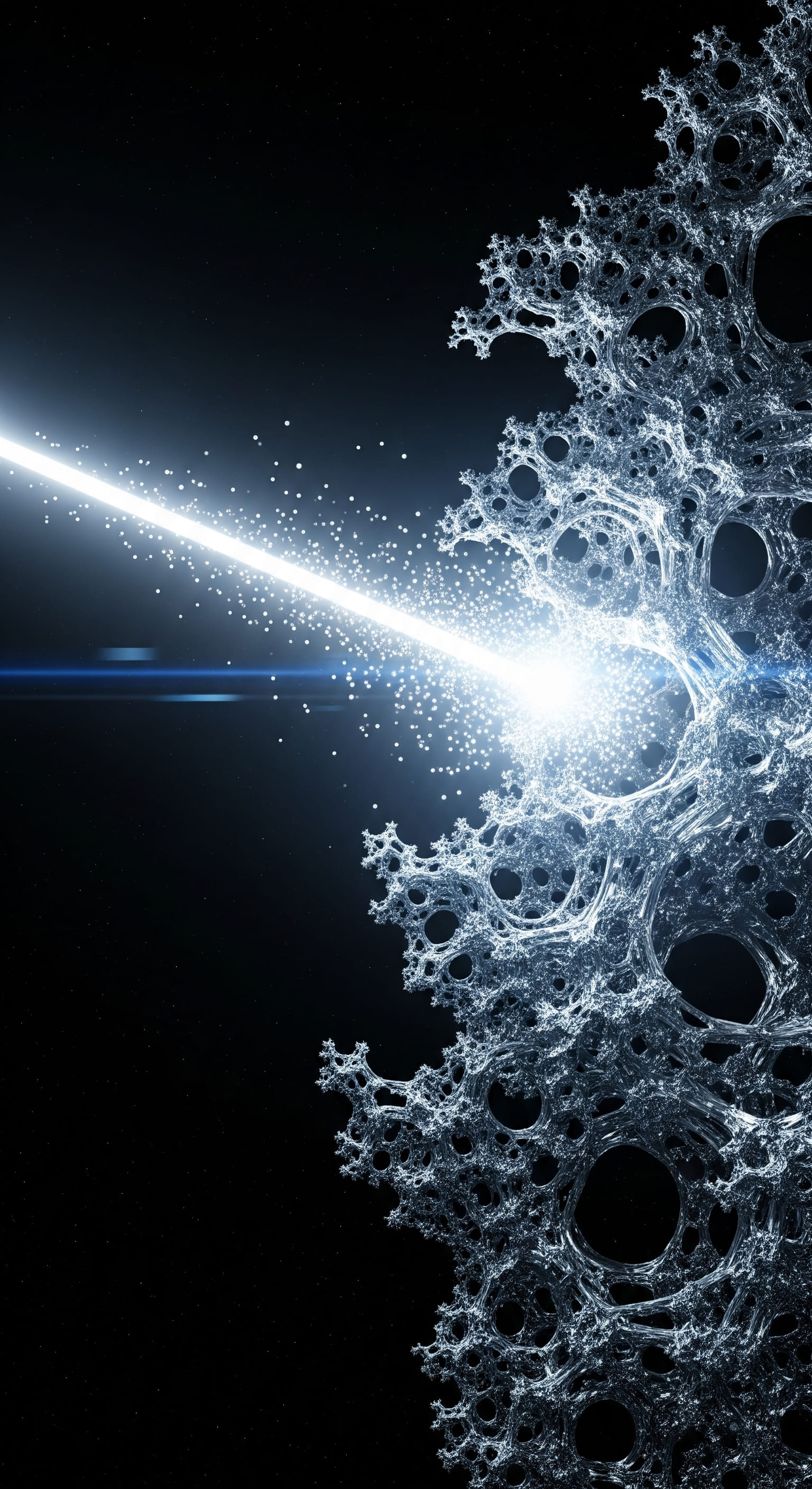The Fine-Structure Constant
Abstract
The fine-structure constant, α, a dimensionless number approximately equal to 1/137 that dictates the strength of electromagnetism, has remained one of the most profound mysteries in physics since its discovery. The Standard Model requires its value as an experimental input, offering no explanation for its origin. This article explores the history of this enigma and presents the Predictive Universe (PU) framework's solution: a complete, parameter-free derivation of α from first principles. We show how the constant emerges not from the dynamics of fields and charges, but from the fundamental logic and thermodynamics of self-reference. The derivation begins with the Horizon Constant (K₀ = 3 bits), the minimum complexity for a system to model itself, and the irreducible thermodynamic cost of this process (ε = ln 2). These two constants, when instantiated in the framework's ideal equilibrium state - the PCE-Attractor - uniquely determine the information-theoretic properties of the underlying predictive substrate. This, in turn, fixes the bare value of the electromagnetic coupling. The result is a sharp, falsifiable prediction that connects the strength of light and matter to the very logic of a self-knowing universe.
This article outlines the conceptual journey of the derivation.
For readers interested in the rigorous mathematical proofs and the full theoretical structure, the complete academic paper is available on GitHub.
1. The Universe's Magic Number
In the grand architecture of the cosmos, there are certain numbers that appear to be the universe's fundamental settings - constants of nature that dictate the very fabric of reality. Among them, one stands out for its purity and its mystery: the fine-structure constant, denoted by the Greek letter alpha (α). It is, in essence, the cosmic dimmer switch for electromagnetism. It governs the strength of the interaction between light and matter, determining everything from the stability of atoms and the fusion processes in stars to the very possibility of chemistry and life.
Unlike other constants, α is dimensionless - it is a pure number, approximately 1/137.036, that is the same regardless of the system of units used. This purity has captivated physicists for over a century. It combines three of nature's most fundamental constants - the elementary charge (e), the speed of light (c), and Planck's constant (ħ) - into a single, elegant ratio. The fact that this specific value appears to be so finely tuned for a universe like ours has led to endless speculation. If α were just a few percent different, stars would not be able to create carbon, atoms might not be stable, and the universe as we know it could not exist.
Richard Feynman famously described it as a "magic number" that comes to us with no understanding:
"A magic number that comes to us with no understanding by man. You might say the 'hand of God' wrote that number, and 'we don't know how He pushed his pencil.' We know what kind of a dance to do experimentally to measure this number very accurately, but we don't know what kind of dance to do on the computer to make this number come out, without putting it in secretly!"
This is the heart of the problem. In our most successful theory of particle physics, the Standard Model, α is a free parameter. We must measure it in an experiment and plug it into our equations by hand. The theory works perfectly once we do, but it offers no clue as to why the number has the value it does. It is a fundamental piece of the cosmic code that remains completely undeciphered.

Universe 00110000
2. A Short History of α
The quest to explain α has a long and storied history, often veering into the territory of pure numerology. The physicist Arthur Eddington, in the early 20th century, famously became convinced that α was exactly 1/136, and later, 1/137, deriving these values from esoteric considerations about the number of dimensions and fundamental particles. While his attempts were ultimately dismissed, they highlight the deep-seated desire among physicists to believe that such a fundamental number could not be random.
While Eddington's approach was sidelined, the fascination with α captivated the very architects of quantum theory. Wolfgang Pauli, one of the most brilliant and critical minds in physics, was famously obsessed with the number. He saw its explanation as a key to the next great breakthrough in physics.
Paul Dirac, whose relativistic equation for the electron is a cornerstone of modern physics, was equally preoccupied. He explored the idea that the fundamental constants might not be constant at all, but could evolve with the age of the universe. This deep unease from the founders of quantum theory underscores the centrality of the problem: α was not a peripheral detail but a profound puzzle that pointed to a fundamental gap in their understanding of the world.
This deep theoretical puzzlement has largely given way to a more pragmatic acceptance in modern times. The Standard Model simply absorbed α as one of its ~25 unexplained parameters. The most common "explanation" offered today is a philosophical one: the anthropic principle. This principle argues that we observe the value of α to be ~1/137 because if it were significantly different, we wouldn't be here to observe it. A universe with a different α would be a sterile one, incapable of producing conscious observers.
While logically sound, the anthropic principle is deeply unsatisfying to many scientists. It explains the consistency of our existence with the laws of physics, but it does not explain the origin of those laws or their parameters. It is an admission that we may never find a deeper reason, resigning us to the possibility that our universe is just one of a near-infinite number of universes in a "multiverse," each with random settings, and we simply happen to live in one where the dials were set correctly for life. The quest for a true theory of everything, however, holds out for a more profound answer - a theory where the value of α is not an accident of our particular universe, but a necessary and calculable consequence of the fundamental laws of reality.
3. The Predictive Universe Solution: A Constant from Logic and Thermodynamics
The Predictive Universe (PU) framework offers a radical alternative to this impasse. It takes a novel approach, starting not with matter and energy, but with the one thing we know with certainty: the existence of a predictive, information-processing awareness. It asks: what must the laws of a universe be like if they are to emerge from the operational logic of such a system? The framework proposes that the value of α is not a fundamental setting of a pre-existing physical world, but an emergent and necessary consequence of a universe that is, at its core, an information-processing system engaged in self-prediction. The framework claims that α is fixed by the absolute, minimal requirements for a system to be able to model itself and its environment in a logically and thermodynamically consistent way.
Instead of starting with fields, particles, or strings, the PU framework begins with the operational logic of prediction itself. It posits that reality is constituted by a network of Minimal Predictive Units (MPUs), the most basic entities capable of a self-referential predictive cycle. The entire structure of physics, including its fundamental constants, is derived from the optimization imperatives governing this network, chiefly the Principle of Compression Efficiency (PCE). In this view, the fine-structure constant is not a parameter of electromagnetism; it is a parameter of optimal information processing in a self-predicting reality.

Universe 00110000
4. The Derivation: A Journey from Self-Reference to Light
The PU framework's derivation of α is a multi-step deductive chain that connects the abstract logic of self-reference to the concrete physics of electromagnetism. It is a parameter-free calculation, meaning its inputs are not measured experimental values but are themselves constants derived from the framework's own internal logic.
- Step 1: The Horizon Constant (K₀ = 3 bits). The journey begins with the Self-Referential Paradox of Accurate Prediction (SPAP), a Gödel-like proof showing that no system can perfectly predict its own future state. The framework proves that the absolute minimum information capacity required to robustly encode the logic of this paradox is exactly 3 bits, corresponding to 2³ = 8 distinguishable internal states. This establishes the Horizon Constant (K₀ = 3 bits), as a fundamental constant of logic. This implies the MPU's internal Hilbert space must have a dimension of at least 8.
- Step 2: The Thermodynamic Cost of Logic (ε = ln 2). The predictive cycle that instantiates this logic is not cost-free. To avoid paradox, the cycle must contain a logically irreversible step - an erasure of information. By Landauer's principle, the erasure of one bit of information has a minimum, unavoidable thermodynamic cost (entropy production) of ε = ln 2 nats. This is the irreducible "heat of thought" for a minimal self-referential system.
- Step 3: The Minimal Machine (The Landauer Pointer). The Principle of Compression Efficiency dictates that this fundamental `ε`-cost must be instantiated in the most resource-efficient way possible. The framework shows that this leads to a specific internal structure for the MPU: the 8-dimensional state space is partitioned into a 2-dimensional "active" subspace (the minimal system that can represent a one-bit erasure) and a 6-dimensional "inactive" complement. This 2-state active subspace is called the "Landauer Pointer."
- Step 4: The System's Sensitivity Spectrum. The next step is to quantify how this minimal predictive machine responds to a small perturbation, which will eventually be identified with the electromagnetic field. The sensitivity of a quantum system is described by its Quantum Fisher Information (QFI). The framework calculates the QFI spectrum for the MPU in its baseline state. The unique structure of the 2-state pointer interacting with its 6-state complement generates a specific sensitivity spectrum: it has exactly M = 24 independent information-carrying modes, and each mode has an equal, normalized sensitivity of λ = 1.
- Step 5: The Optimal Coupling (The PCE-Attractor). The system, driven by PCE, seeks an ideal equilibrium state of maximal efficiency and symmetry, known as the PCE-Attractor. Think of the PCE-Attractor as the universe's "factory default setting" - the most stable, robust, and resource-efficient state the MPU network can settle into. The framework argues that in this state of perfect optimization, the system's properties become uniquely fixed. It operates at its absolute information capacity limit, a state justified by the framework's Operational Alphabet-Capacity Theorem. This theorem shows that the most efficient way for an MPU to leverage its full potential is to access all of its `d₀ = 8` internal states, setting the ultimate information ceiling at `ln 8` nats per interaction. This imposes a powerful constraint that links the strength of the coupling (`u = gₑ²`) to the MPU's alphabet size (`d₀ = 8`) and its number of sensitivity modes (`M = 24`). The constraint takes the form of a simple, parameter-free equation.
24 ln(1 + u) = ln 8
Solving this equation for `u` gives a unique, non-zero value for the bare squared coupling strength. Finally, converting this to the fine-structure constant using the standard relation `α = u / (4π)` yields the result.
1 / α ≈ 138.843
This direct conversion is justified by a deep consistency principle within the framework, the Predictive Ward Identity, which proves that in the state of perfect efficiency (the PCE-Attractor), the normalization factor between the informational coupling and the physical coupling is exactly one. The universe, in its optimal state, uses the simplest possible dictionary to translate its internal logic into physical law.

Universe 00110000
5. The Probability of Deriving a Fundamental Constant
What is the probability of deriving a fundamental constant of nature to within ~1% of its known high-energy value by sheer luck, starting from a completely unrelated set of first principles? It is, for all practical purposes, zero. The success of this calculation is therefore not a coincidence; it is profound evidence for the internal consistency and potential correctness of the entire deductive chain and the foundational axioms of the Predictive Universe.
It is crucial to be precise about what this number represents. The calculated value of `1/α ≈ 138.843` is not the low-energy value of ~137.036 that we measure in tabletop experiments. It is the bare, high-scale boundary condition for the electromagnetic coupling, defined at the fundamental operational scale of the MPU network. In standard Quantum Field Theory, coupling constants "run" with energy - their effective strength changes depending on the energy of the interaction. To connect the PU framework's bare value to the measured low-energy value, one must perform a standard calculation to account for the effects of this running and other quantum corrections. This calculation shows that a bare value of ~138.843 at a high scale is entirely consistent with the observed value of ~137.036 at low energies. The PU framework does not just produce a number; it provides the correct high-energy input for the Standard Model's own machinery.
Furthermore, the power of the PCE-Attractor concept extends beyond the fine-structure constant. The same state of perfect efficiency that fixes the value of `α` also makes a second, independent prediction: it uniquely determines the ratio of the universe's fundamental 'benefit-conversion' factor to its 'cost-of-complexity' coefficient. This provides another sharp, falsifiable prediction, demonstrating that the framework's core parameters are not independent but are locked together by the same principle of optimal design.
The importance of this result cannot be overstated. It transforms the fine-structure constant from "magic number" into a calculable consequence of a self-consistent, self-predicting reality. It is a powerful demonstration that the constants of nature may not be arbitrary dials set at the beginning of time, but are instead the unique, stable parameters that emerge from the universe's own operational logic.

6. Conclusion
The mystery of the fine-structure constant has long stood as a symbol of the limits of our understanding, a hint that a deeper layer of reality awaits our discovery. The Predictive Universe framework proposes that this fundamental stratum is woven from information, logic, and prediction. From this perspective, the strength of the force that holds atoms together and carries light across the cosmos emerges as a direct consequence of the logic required for a minimal entity to think about itself.
The derivation of α from first principles is a testament to the framework's potential. It reveals a universe that is a coherent, self-regulating system, whose physical properties are the necessary outcome of its own informational dynamics. The constants of nature are therefore the stable parameters of a universe tuned by the very act of prediction. The magic number is, perhaps, the number of a self-knowing cosmos.

